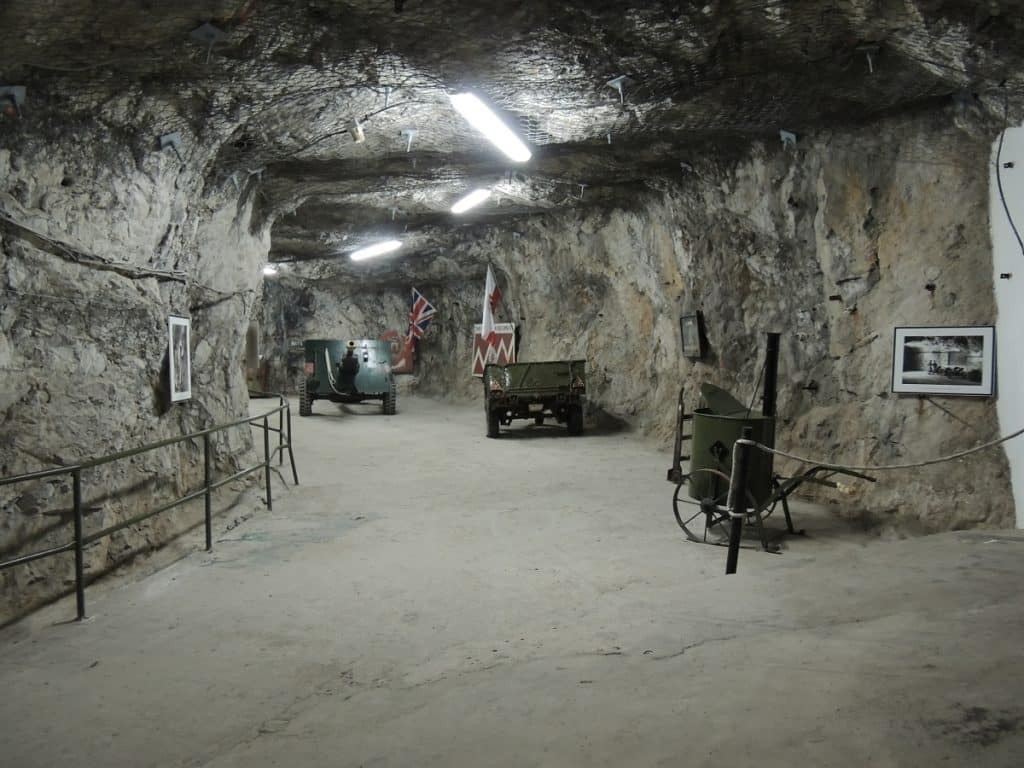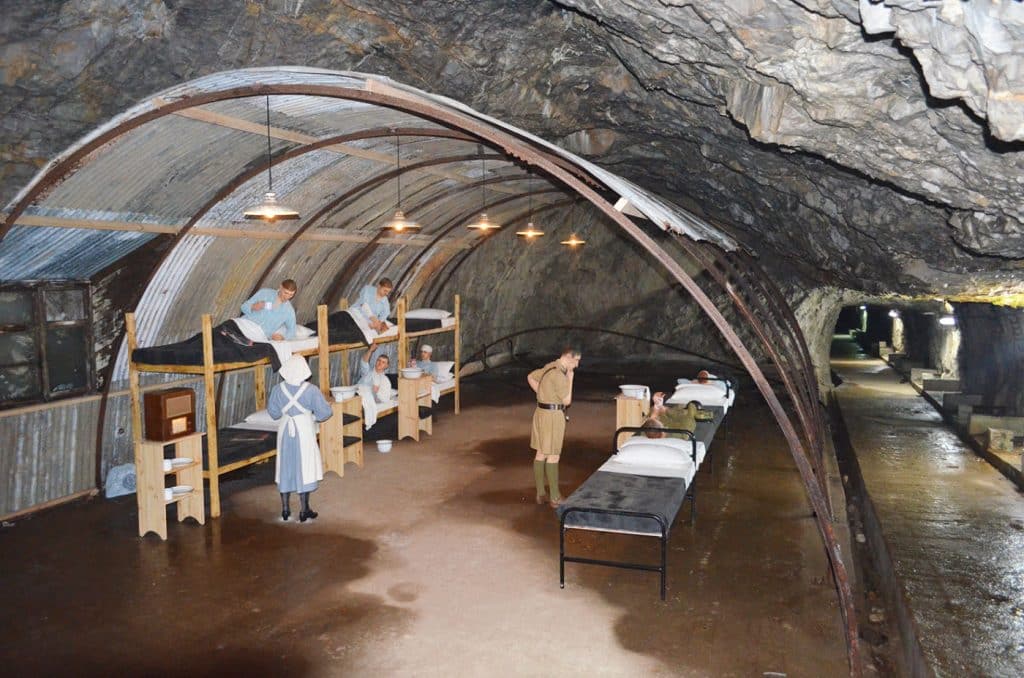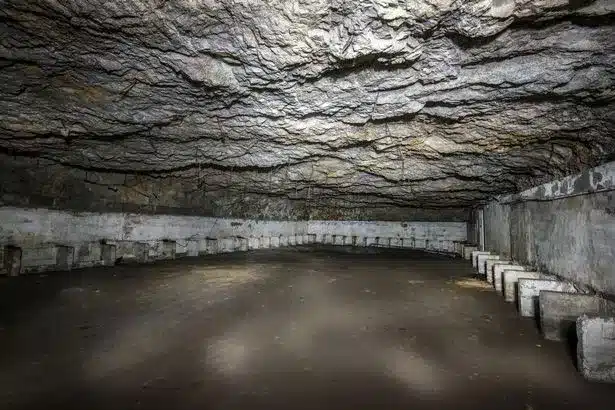World War II Tunnels History: A Testament to Resilience
Hidden beneath the Rock of Gibraltar, the World War II Tunnels are a labyrinth of ingenuity, resilience, and strategic planning. Built during one of the most challenging periods in history, these tunnels played a crucial role in defending Gibraltar and supporting Allied forces during World War II. Today, they stand as a remarkable tribute to human determination and engineering brilliance, offering visitors a chance to explore the fascinating history carved into the heart of the Rock.

Wartime Construction: Engineering Feats Under Pressure
The construction of the World War II tunnels was a response to the escalating threats of the Second World War. Gibraltar’s strategic location at the entrance to the Mediterranean made it a target, prompting the British military to expand its underground infrastructure. Over 30 miles of tunnels were constructed during this time, making Gibraltar an impenetrable fortress.
What Did a Tunneller Do in WW2?
Tunnellers were unsung heroes of the war effort. Working under extreme conditions, they excavated rock to create an underground city equipped with hospitals, barracks, and storage facilities. Their tasks included:
- Blasting and digging through limestone with limited resources.
- Installing ventilation systems to ensure breathable air.
- Reinforcing tunnels with concrete to withstand potential attacks.
The result was a network of tunnels that could sustain 16,000 troops and essential supplies for prolonged periods.
Famous Tunnels Inside the Rock
Among the most notable is the Operation Torch Headquarters, where Allied forces planned their invasion of North Africa. This room, along with many others, illustrates the strategic importance of Gibraltar’s underground network.
Strategic Location: Gibraltar During WW2
The Rock of Gibraltar has long been a vital stronghold, but its significance reached new heights during World War II. Positioned at the crossroads of Europe, Africa, and the Atlantic Ocean, Gibraltar allowed the Allies to control access to the Mediterranean Sea.
Gibraltar Tunnels and Allied Operations
The tunnels served as a logistical hub for Allied forces, enabling:
- Safe storage of weapons, ammunition, and rations.
- Emergency shelters for soldiers during air raids.
- Secure communication lines between command centres.
The Battle of Gibraltar in WW2 showcased the Rock’s defensive capabilities, with the tunnels playing a pivotal role in protecting the garrison from attacks.

Exploring World War II Tunnels: A Journey Through Time

Today, the World War II tunnels in Gibraltar offer a captivating journey into the past. Visitors can step inside the same spaces where soldiers and engineers worked tirelessly to safeguard this critical stronghold.
Guided Tours
Guided tours provide an immersive experience, offering detailed insights into the construction, significance, and stories of the tunnels. Highlights include:
- Operation Torch Rooms: Learn how this Allied invasion turned the tide of the war.
- Barracks and Storage Facilities: See the spaces that housed troops and supplies during the conflict.
The tours are designed to bring history to life, making them engaging for visitors of all ages.
Architectural Marvels
The tunnels are a testament to wartime innovation. Their design includes:
Ingenious layouts that allowed seamless movement of troops and supplies.
Advanced ventilation systems to support underground operations.
Hidden entrances and exits to evade enemy detection.
World War II Tunnels Significance: Defenders of Gibraltar

The tunnels were more than just a defensive measure—they were a lifeline for Gibraltar’s population and the Allied forces. Their significance is highlighted by the courage and sacrifice of those who worked and fought within their walls.
Immersive Experience
Walking through the tunnels evokes a sense of connection to the past. Visitors can almost hear the echoes of soldiers’ footsteps and the distant hum of wartime activity.
Allied Efforts
Gibraltar’s tunnels played a critical role in Allied victories, supporting missions such as:
- Operation Torch: The successful invasion of North Africa.
- Monitoring Axis naval movements in the Mediterranean.
These efforts cemented Gibraltar’s reputation as an indispensable stronghold in the war effort.
Courage and Sacrifice
The stories of those who worked in the tunnels—both soldiers and civilian workers—reflect immense bravery. Many faced dangerous conditions, including rockfalls, air raids, and long hours underground.
Plan Your Visit
Tours of the tunnels typically last 1-2 hours, with knowledgeable guides providing in-depth commentary. To fully appreciate the experience, it’s recommended to wear comfortable shoes and arrive with curiosity for history.
World War II Tunnels Experience: A Tribute to History
The tunnels are more than just a historical site; they are a tribute to the resilience and ingenuity of the wartime generation. Visiting them provides a deeper understanding of Gibraltar’s role in shaping global events during World War II.
Location and Access
The tunnels are located within the Upper Rock Nature Reserve, making them easily accessible from central Gibraltar. Guided tours often include transport options, ensuring a hassle-free visit.
Plan Your Visit Today
Visiting the World War II tunnels in Gibraltar is an experience like no other. Whether you’re a history enthusiast or simply curious about what lies inside the Rock, these tunnels offer a unique glimpse into the past. From the bravery of the tunnellers to the strategic brilliance of Allied forces, every corner of this underground network tells a story.
Book your tour today and step into a world of resilience, courage, and history beneath the Rock of Gibraltar.
FAQ
The guided tour through the World War II Tunnels typically lasts approximately 30 – 40 minutes
Visitors can experience a tour through an underground city, exploring tunnels that served various purposes during World War II. Static exhibitions and photographic displays are included in the tour.
Yes, the tunnels feature specific exhibits and interactive elements. Visitors can engage with static displays and photographic exhibitions that highlight the wartime history of the tunnels.
The guided tours are suitable for all ages, and there are no specific age restrictions mentioned. Families are encouraged to participate, providing an educational and historical experience for visitors of all ages.
The WWII Tunnels have comprehensive security measures in place to ensure the safety of visitors: surveillance systems and compliance with safety regulations to protect against potential risks.
Accessibility considerations for visitors with mobility issues have been taken into account in the tunnels. Our guides can make provisions on request to facilitate the movement of people with mobility problems, ensuring that the tour is accessible to a wide range of visitors.
